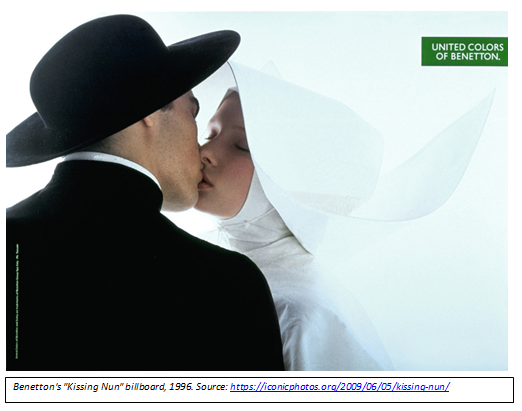Christianity Sells: When Advertisers use Christianity to Sell.
Christianity has become a key player in promoting non-religious brands, products, and services. Jesus is employed as a salesman for the profane and God offers the ultimate celebrity endorsement.

“Christianity Sells” describes an advertising technique that uses Christian symbols and ideas to sell products, brands and services. It works in a similar manner to Sex Sells, where sexual imagery is associated with a product to give it a sexual appeal. When products are associated with Christian ideas and symbols the meaning they hold is transferred over to the product.
Using Christianity to sell is not a new idea. Although it is not possible to pinpoint the earliest use, there has always been a strong connection between Christianity and promotional messages. This is in part explained by recognising that advertising and Christianity function in a similar way. They both “address and propose solution to human desire and [quest] for identity and meaning” (Peck, 1993, p. 6). For some, advertising has become “a key agent in the construction of modern identity”, this was a role once held predominately by religion (Peck, 1993, p. 6). Jeremy Carrette and Richard King (2005, p. 1) argue that “God is dead but has been resurrected as Capital.” Richard Santana and Gregory Erickson (2008, p. 114) write that religion exists in the market place of ideas, resulting in media and popular culture “rescripted the sacred” (Santana & Erickson, 2008, p. 114).
The use of religion in advertising is on the rise (Maguire & Weatherby, 1999; Weatherby and Pugh, 2008, Mallia, 2009). Karen Mallia (2009, p. 173) claims that there has been a shift in the way advertisers use religion to sell. The incidental, “infrequent” and “innocent” representations of religion in the 1950s and 1960s have been replaced with “more frequent, more daring, and more controversial” portrayals of religion (p. 173). One of the reasons for this is because religion can provide the shock value to break through “media clutter” (Mallia, 2009, p. 172).

CHRISTIANITY SELLS IN NEW ZEALAND
There are three main reasons why New Zealand is an interesting case study for examining Christianity in advertising.
New Zealand has one of the most deregulated media industries in the world.
There is no specific rules controlling how religious organisations can advertise or how religious imagery and themes can appear in advertisements.
New Zealand has a historical connection with Christianity, but is becoming an increasingly secular culture. In the 2013 NZ Census 48.01% of the population self-identified as Christian, while 41.92% self-identified as non-religious.
With this in mind, two assumptions can be made about how the relationship between Christian cultural markers and advertising in New Zealand.
Religious imagery could be undesirable to advertisers on the assumption that it is not relevant to a large proportion of the audience.
There could be more opportunities for controversial and daring uses of religious imagery in advertisements because of the secularising culture and loose advertising rules about religion.
So is Christianity being used to sell in New Zealand?
Yes, absolutely!
Pure Blonde Beer is “Heaven Sent”, Charlie’s Orange Juice was “Made by God”, Cadbury is “into Easter as much as you are”, The Warehouse is the place “for the Christmas kiwis want”, Farmers is “your Christmas store”, SKY Television is “your happy place”, NZ Post said “send, and you shall receive”, Eshe streetwear declared “religion is garbage”, and Hell Pizza has us all going to Hell!
And these are just a few examples.

In 2012, I conducted a content analysis to quantify the amount of Christian cultural markers in television advertisements. The data was taken from five free-to-air channels over four weeks in 2012 during prime-time hours (6pm – 10.30pm). In all, the study covered 630 hours of programming over 28 days. Three days were not included in data because they are legally non-advertising days (Good Friday, Easter Sunday and Christmas Day). On all advertising days there is no limit to the amount of commercial messages that can be broadcast. (Gould, 2017).
Over a four week period, 500 Christian cultural markers appeared in 307 texts - 192 television commercials and 115 promos (Gould, 2007, p. 88; 89; 91)

TELEVISION ADVERTISEMENTS ARE CULTURAL TEXTS. THEY EXIST AND OPERATE WITHIN A CULTURAL CONTEXT.
Stephen Turner (2004, p. 179) explains that “adverts are stories about who we are, what we do, and what we value”.
This introduction to Christianity Sells has revealed three key ideas:
Advertisers use Christian images and ideas not only for shock value but to make a product or brand more appealing.
The religious authority of Christian ideas and symbols is declining as it continues to be used by non-religious organisations.
Christian cultural makers can still have value and meaning in a culture that is secularising.
THIS ARTICLE IS AN ORIGINAL CONTRIBUTION
Author: Melissa Gould, Ph.D (AUT), MCS, BCS (Hons), BCS.
Dr Melissa Gould holds a Ph.D from the School of Communications at Auckland University of Technology in Auckland, New Zealand. She worked as a Media and Communications Lecturer at the School, and now works as an independent researcher and writer. Her primary research areas include media communication theory and cultural studies that examine religion, gender, childhood and commercialism.
website: http://www.sowhat.co.nz/
facebook: https://www.facebook.com/QuestionSoWhat/
References:
Carrette, J., & King, R. (2005). Selling spirituality: The silent takeover of religion. London, England: Routledge.
Gould, M. (2017). Christianity sells and the advertiser’s toolbox: The work of Christian Cultural Markers in television advertisements (Unpublished doctoral thesis). Auckland University of Technology, Auckland, New Zealand.
Maguire, B., Sandage, D., & Weatherby, G. (1999). Television commercial content: Religion versus science and professional expertise. Sociological Focus, 32(4), 413-425.
Mallia, K.L. (2009). From the sacred to the profane: A critical analysis of the changing nature of religious imagery in advertising. Journal of Media and Religion, (3) 172-190.
Peck, J. (1993). The Gods of televangelism: The crisis of meaning and the appeal of religious television. Cresskill, NJ: Hampton.
Santana, R. W., & Erickson, G. (2008). Religion and popular culture: God as nothing solid. London, England: McFarland & Company.
Turner, S. (2004). Inside advertising culture. In L. Goode & N. Zuberi (Eds.), Media studies in Aotearoa/New Zealand (pp. 170-182). Auckland, New Zealand: Pearson Education.
Weatherby, G. A., & Pugh, J. (2008). The secularization of religion and television commercials in the U.S.: An update. Journal of Sociology, Social Work and Social Welfare, 2(1), u.p.